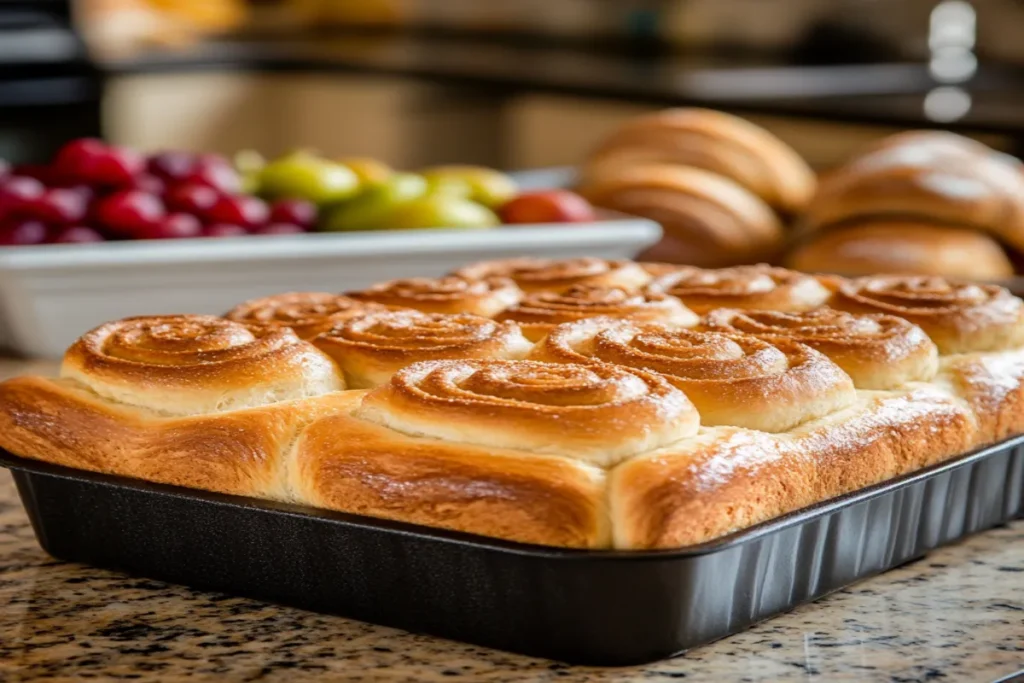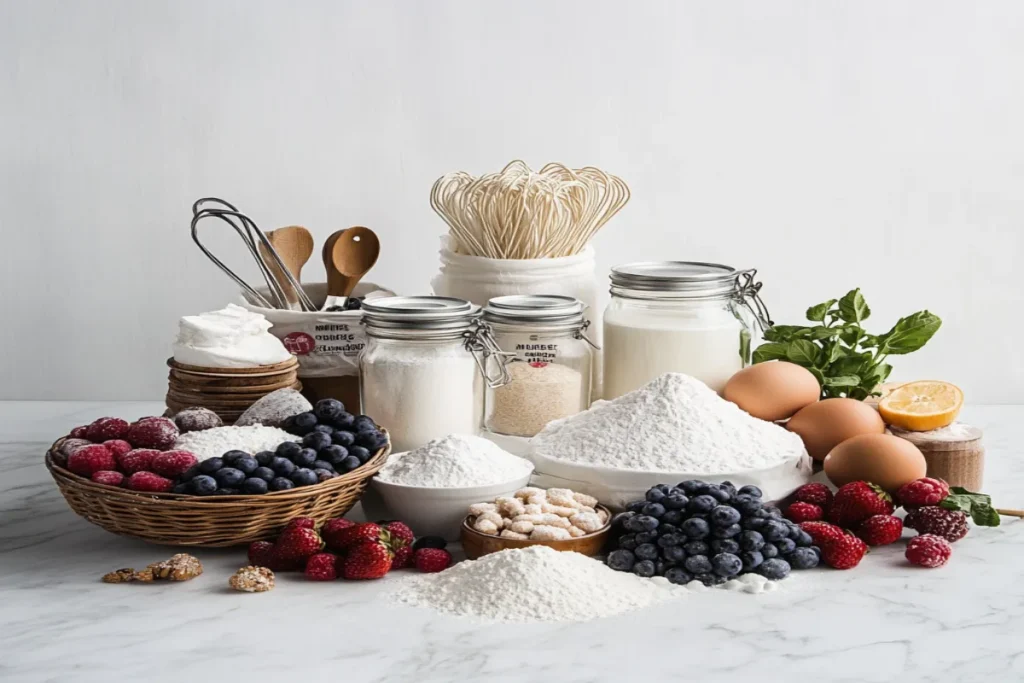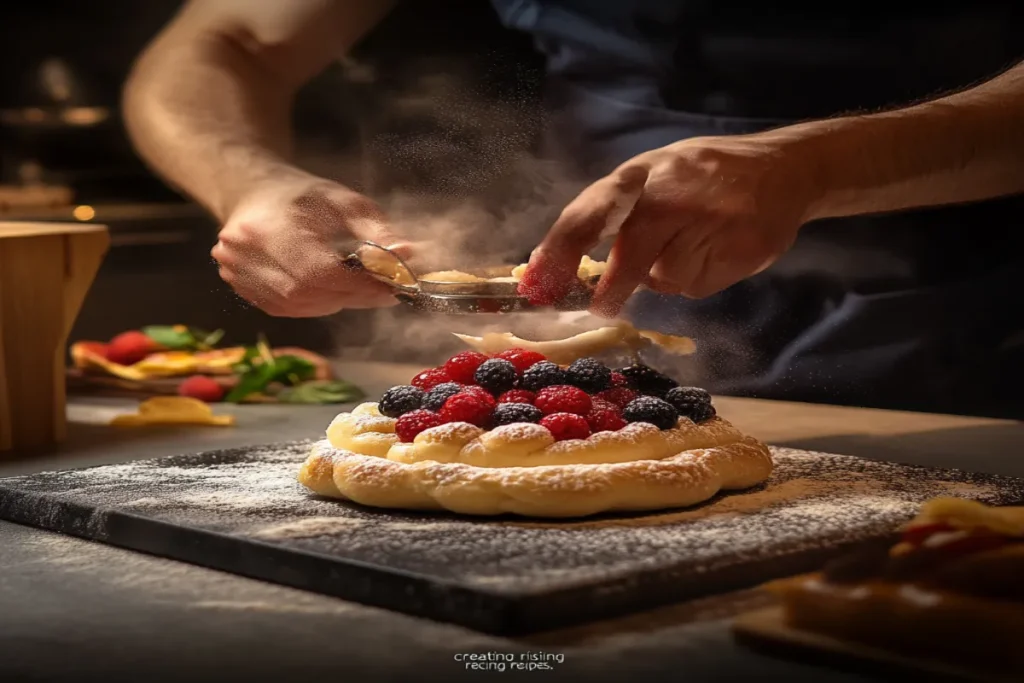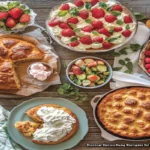Welcome to the exciting world of rising recipes. Here, cooking turns simple meals into tasty masterpieces. These recipes use yeast to make food light and full of flavor.
Whether you’re having a dinner party or a quiet night in, rising recipes can make any meal special. As you check out the latest food trends, you’ll see rising recipes are here to stay. They’re key for making dishes that are both easy to make and impressive.
Get ready for a journey of flavors that will make your meals more exciting. It’s all about mixing creativity with comfort at your table!
Table of Contents
What Are Rising Recipes?
Rising recipes are dishes that use leavening agents to make them light and fluffy. These agents, like yeast and baking powder, add gas bubbles to the dough. This makes the dough expand, creating the airy textures we love in baked goods.
These recipes are key to making delicious breads, pastries, and other treats. They show the skill and knowledge needed to make food rise. This process is essential for the light, airy feel of many modern recipes.
Defining Rising Recipes
Rising recipes rely on special ingredients to rise. Yeast, baking powder, and baking soda are common ones. Each one plays a part in creating the texture and taste of the final product.
Yeast, for example, helps the dough rise and adds flavor through fermentation. This mix of ingredients is what makes rising recipes so special.
Why They Matter in Today’s Cooking
Rising recipes are vital in today’s cooking world. They add texture and presentation to our meals. In a world where taste and looks matter, rising recipes are more popular than ever.
They offer a way to make homemade dishes that impress. Whether you’re baking a classic bread or trying new flavors, mastering rising recipes can elevate your cooking.

Ingredients for Creating Rising Recipes
Starting a rising recipe journey means knowing the key ingredients. A well-stocked pantry is essential. It lets you try new things. Choosing the right ingredients boosts your dish’s flavor.
Key Pantry Staples
To excel in rising recipes, keep certain ingredients ready. Here’s a list of pantry essentials:
- Garlic
- Shallots
- Extra virgin olive oil
- Unsalted butter
- Pasta varieties
- Canned tomatoes
- Various cheeses
These items add vital flavor and are the base for many dishes. Yeast, for instance, is key for light, airy textures in bread and more.
Creative Additions for Flavor
Adding new flavors can make your recipes stand out. Try these:
| Ingredient | Flavor Enhancement | Usage |
|---|---|---|
| Herbs (e.g., rosemary, basil) | Adds freshness and aromatic qualities | Mix into dough or sprinkle on top |
| Spices (e.g., cinnamon, nutmeg) | Provides warmth and depth | Incorporate into sweet rising recipes |
| Citrus zest (e.g., lemon, orange) | Adds brightness | Mix into dough or batter |
| Cheese blends (e.g., mozzarella, ricotta) | Enhances creaminess and richness | Fill or top before baking |
Trying new flavors can make your recipes unforgettable. Having these ingredients for rising recipes ready lets you try both classic and new dishes. Whether it’s quick recipes or more complex ones, your pantry is key to your cooking journey.

How to Create Rising Recipes That Everyone Will Love
Creating rising recipes is a great way to make delicious meals for everyone. Follow the cooking instructions carefully to get the best results. Start with something like garlic butter parmesan knots. They’re easy to make and taste amazing.
Then, try creamy sun-dried tomato pasta. It’s quick to make and packed with flavor. These recipes are simple but impressive, perfect for any occasion.
Below is a table summarizing key ingredients and cooking times for some favorite rising recipes:
| Recipe | Servings | Total Time |
|---|---|---|
| Garlic Butter Parmesan Knots | 12 servings | 40 minutes |
| Creamy Sun-Dried Tomato Pasta | 4 servings | 30 minutes |
| Layered Breakfast Bake | 10 servings | 1 hour 50 minutes |
| Pumpkin Bread | 16 pieces | 1 hour 20 minutes |
Using fresh ingredients makes cooking more fun and rewarding. It’s time to start making these tasty dishes that everyone will enjoy!

Classic Rising Recipes Every Cook Should Master
Exploring classic recipes opens a world of flavors. You can make sourdough bread, dinner rolls, and pizza dough. These recipes turn simple ingredients into tasty dishes for any meal.
Traditional Sourdough Bread
Learning to make sourdough bread is a journey. It involves understanding fermentation, kneading, and rising. This bread has a tangy taste that makes any dish better.
With time and effort, you can achieve a crusty outside and a soft inside. Your sourdough will be a highlight of any breadbasket.
Basic Dinner Rolls
Dinner rolls are a staple in many homes. They are soft and fluffy, perfect for any meal. You can adjust the recipe to make them your own.
This way, dinner rolls become a favorite side dish on your table.
Classic Pizza Dough
Every great pizza starts with good dough. This dough is easy to make and lets you try different toppings. You can make thin crust or deep-dish pizzas at home.
Mastering this recipe means you can have your favorite pizza nights whenever you want.
Innovative Twists on Traditional Rising Techniques
In the world of cooking, adding ancient grains to traditional recipes can be a game-changer. These grains not only boost nutrition but also add exciting textures to classic dishes. By using unique ingredients, you can create flavors that appeal to many, making your cooking more versatile.
Using Ancient Grains
Ancient grains like quinoa, spelt, and farro offer a richer taste and more nutrients than regular wheat. They can turn simple bread and rolls into something truly special. You can use these grains as a base or even as flour substitutes in your recipes. For example:
- Quinoa bread has a nutty taste and is packed with protein.
- Spelt donuts add a sweet, earthy flavor that pairs well with traditional recipes.
- Farro dinner rolls add fiber and texture to your meals.
Mixing Techniques for Unique Dishes
Mixing old rising techniques with new ones can lead to amazing results. You can try different mixing methods to make dishes that amaze and please. For example, using a no-knead method can create a rustic loaf with a unique taste and texture. Some key methods include:
- Adding fermentation to introduce sourdough flavors in non-sourdough recipes.
- Using overnight rests for deeper flavors while keeping traditional rising methods.
- Changing dough hydration levels to get different textures in baked goods.
Quick-Rise Solutions for Busy Schedules
In today’s fast world, quick cooking is key for happiness and health at home. Busy families look for rapid-rise solutions that are quick and tasty. No-wait bread recipes and rapid-rise yeast make delicious meals in minutes.
No-Wait Bread Recipes
No-wait bread recipes are perfect for fresh bread without long waits. Quick flatbreads or simple soda breads offer fluffy texture and rich flavors. They’re great for family meals or gatherings, without sacrificing taste.
Using Rapid-Rise Yeast
Rapid-rise yeast is a fast alternative to standard yeast. It cuts down rise time, making baking quicker. With it, pizzas and rolls can become family favorites, satisfying your cravings fast.
Global Rising Recipes Trending Now
As you explore the world of cooking, you’ll find a wide range of global recipes. These dishes show the rich tastes of cultures from around the globe. People are now looking for international flavors, making it key to add unique touches to your meals. Here are some popular recipes that are making waves in kitchens everywhere.
Japanese Milk Bread
This bread is loved for its soft and fluffy texture. The secret is the tangzhong starter, which boosts both taste and texture. It’s great for breakfast or with any meal, making it a must-try dish.
Indian Naan
Indian naan is a hit worldwide. It’s a leavened flatbread often served with curries or grilled meats. Adding garlic or herbs makes it even more tempting for dinner.
Italian Focaccia
Italian focaccia is another exciting way to enjoy international tastes. This thick, oven-baked bread can be topped with olives, rosemary, and more. Its aroma and texture make it perfect for any occasion, from family dinners to cozy nights in.
Understanding the Science Behind Rising Recipes
To truly appreciate baking, you must learn about the science of cooking, focusing on understanding yeast. Yeast is key in fermentation, turning sugars into carbon dioxide and alcohol. This is vital for the lift and texture in many recipes.
The way yeast works depends on temperature, enzyme action, and how ingredients mix. These factors are all part of baking principles.
Mixing flour with water damages some starch granules, making enzymes more accessible. Enzymes like amylase and protease break down starches and proteins. This helps the dough rise and get its structure.
For active dry yeast to work best, it needs to bloom in lukewarm water. The temperature should be between 40–43 °C (104–109 °F).
Instant yeast ferments faster because of its finer granules. It produces more gas than active dry yeast. This leads to the dough expanding during the oven spring phase.
At around 50 °C (122 °F), yeast stops working. But the dough keeps rising because of CO2 trapped in the gluten structure. Gluten is made from glutenin and gliadin proteins in bread wheat flour.
The perfect temperature for bread to set its crumb is between 91 and 93 °C (195 and 200 °F). Higher temperatures, above 130 °C (265 °F), make the crust golden-brown through Maillard reactions.
Different fermentation processes add to the flavor of the final product. Knowing this helps you improve recipes and solve common problems.
The fermentation process is affected by the ambient temperature. Warmer climates speed it up but only so far. Understanding these scientific principles helps you bake consistently and well. With the right knowledge of science of cooking, baking becomes both an art and a science.
Troubleshooting Common Rising Problems
Baking can be rewarding but also comes with challenges. Issues like dense dough or uneven rising can be frustrating. Knowing how to fix these problems can improve your baking and make your treats better.
Dense or Heavy Results
Dense dough often comes from inactive yeast or overmixing. Yeast that’s not working might be old or not proofed right. This leads to no rise. Overmixing makes the dough tough, changing its texture.
Make sure your yeast is fresh and active. It should double in size in 3-4 hours after feeding. If you use a sourdough starter, feed it daily to keep it active. Changing how you mix can also make your dough lighter and fluffier.
Uneven Rising Issues
Uneven rising is a big problem and often caused by temperature changes or uneven mixing. Keeping the temperature steady is key for yeast to work well. Also, mix your ingredients evenly.
A dough that’s well mixed will rise evenly, avoiding dense spots. Knowing how to solve these common problems can make your baking easier and help you get the perfect rise.
Seasonal Rising Recipes for Every Occasion
Let’s celebrate the changing seasons with tasty rising recipes. Each season brings its own fresh ingredients. In spring, we enjoy strawberries and asparagus. Winter brings root vegetables and comfort foods.
Using seasonal ingredients makes our meals better. It adds unique flavors to our dishes.
Spring and Summer Flavors
Spring and summer are times for fresh ingredients. Think about using strawberries and herbs from your garden. Mini Strawberry Bundt Cakes are great for Easter and Mother’s Day.
Try a zesty Spring Pea Soup for a refreshing taste. Asparagus adds a burst of freshness to any dish.
Winter Comfort Foods
Winter is the time for warm, comforting dishes. Jamaican-style oxtail stew is perfect for cozy gatherings. It’s tender and flavorful.
For a comforting meal, try Pork Loin Roast with Rhubarb-Orange Sauce. Pair it with seasonal vegetables for a memorable winter meal.
For more delicious recipes and kitchen inspiration, stick around and explore our other articles.
Print
Discover Delicious Rising Recipes for Every Meal
- Total Time: 40min
- Yield: 12 servings 1x
Description
Garlic Butter Parmesan Knots are soft, buttery, and flavorful bread knots that are perfect for any occasion. These knots combine the richness of garlic butter with the savory taste of parmesan cheese, making them an irresistible addition to your meals or gatherings.
Ingredients
- 3 ½ cups all-purpose flour (plus extra for dusting)
- 1 packet (2 ¼ teaspoons) active dry yeast
- 1 cup warm milk (about 110°F/45°C)
- ¼ cup granulated sugar
- ½ teaspoon salt
- 2 large eggs
- ¼ cup unsalted butter, melted
- ½ cup grated parmesan cheese
- 4 tablespoons unsalted butter, melted (for brushing)
- 2 cloves garlic, minced
- Fresh parsley, chopped (optional, for garnish)
Instructions
- Activate the Yeast : In a small bowl, dissolve the yeast and sugar in warm milk. Let it sit for 5–10 minutes until frothy.
- Prepare the Dough : In a large mixing bowl, combine flour, salt, and sugar. Add the yeast mixture, eggs, and melted butter. Mix until a dough forms.
- Knead the Dough : Transfer the dough to a floured surface and knead for 8–10 minutes until smooth and elastic. Place the dough in a greased bowl, cover, and let it rise for 1 hour or until doubled in size.
- Shape the Knots : Divide the dough into equal portions and roll each into a rope. Tie each rope into a knot and place them on a baking sheet lined with parchment paper. Cover and let them rise for another 30 minutes.
- Bake : Preheat the oven to 375°F (190°C). Bake the knots for 15–20 minutes until golden brown.
- Prepare Garlic Butter : Melt the remaining butter and mix with minced garlic. Brush the garlic butter over the baked knots and sprinkle with parmesan cheese. Garnish with fresh parsley if desired.
Notes
- Ensure the milk is warm but not too hot, as temperatures above 130°F (54°C) can kill the yeast.
- For a richer flavor, let the dough risae overnight in the refrigerator.
- Customize the knots by adding herbs like rosemary or spices like paprika to the dough.
Details
- Prep Time: 20min
- Cook Time: 20min
- Category: Bread, Appetizer
- Method: Baking
- Cuisine: American
Nutrition
- Serving Size: 1knot
- Calories: 180kcal
- Sugar: 5gr
- Sodium: 200mg
- Fat: 8gr
- Saturated Fat: 5gr
- Unsaturated Fat: 2gr
- Trans Fat: 0gr
- Carbohydrates: 22gr
- Fiber: 1gr
- Protein: 5gr
- Cholesterol: 25mg
Keywords: Garlic Butter Parmesan Knots, Rising Recipes, Homemade Bread, Easy Bread Recipe, Yeast Recipes

